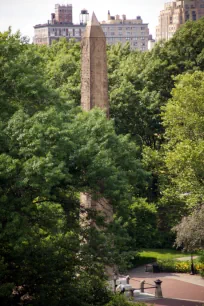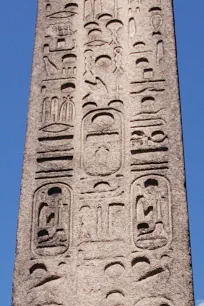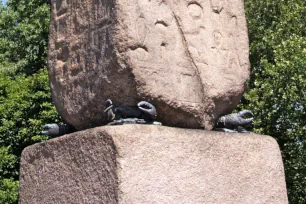Cleopatra’s Needle is an authentic Egyptian obelisk that was transported to New York City in 1881, where it was erected in Central Park. At well over 3400 years of age, the obelisk is by a distance the oldest man-made object in New York.



Early History
In 1443 BC, on the occasion of the thirtieth anniversary of the reign of Pharaoh Thutmosis III, two obelisks were erected in the ancient city of Heliopolis in honor of the sun god Ra. The obelisks were made of red granite and their pyramidal tips were covered in gold. Both obelisks suffered damage in 525 BC during a Persian invasion.
In 12 BC, when Egypt was part of the Roman Empire, the obelisks were transported to the Caesarium in Alexandria. The Caesarium was a temple created by Cleopatra in honor of her deceased lover Julius Caesar. This is probably where the obelisk got its current moniker from.
Over the centuries, the temple and its obelisks suffered from neglect and were partly covered in sand. One of the two toppled over. In 1819, this particular obelisk was donated to the United Kingdom by the viceroy of Egypt.
Transportation to New York
In the nineteenth century, Romanticism and the advent of mass travel caused an increased interest in Ancient Egypt. Plenty of Egyptian obelisks had already been erected in Rome and Paris as status symbols and when an obelisk arrived in London in 1878, New York didn’t want to be left out. The New York World newspaper launched a campaign to acquire an obelisk from Egypt.
As early as the following year, the Egyptian government (possibly in an effort to improve trade relations in the wake of the opening of the Suez Canal) agreed to donate an obelisk from the Caesarium to the United States. London’s still standing twin was selected. The overseas transport was funded by the American railroad tycoon William H. Vanderbilt. The massive, about 200 tonnes weighing monument, was encased in wood and loaded on board the steamship S.S. Denton. The obelisk was too heavy for cranes, so a hole had to be made in the hull of the ship so that the granite monument could be rolled on logs into the hold.
The ship arrived with its precious cargo in Staten Island, New York in June 1880. That wasn’t the end of its trip though. The monument was first loaded onto barges and transported to Manhattan, where it was pulled by a steam engine on a purpose-built rail track.
It finally arrived at its designated site behind the Metropolitan Museum of Art in Central Park in January 1881, where it was raised under the watchful eye of a large crowd. A wooden apparatus that resembled a trebuchet turned the massive monument ninety degrees in a matter of minutes.
The Obelisk
The red granite obelisk measures 21 meters (69 ft.) tall and is covered on all sides with hieroglyphs. The hieroglyphs were added in two phases, first by Thutmosis III; the rest was added about three hundred years later by Ramesses II.

The obelisk rests on its original, 45 tonne weighing base. Between the base and the obelisk are four bronze crabs that keep the monument stable. They were originally added by the Romans. The ones you see now are replicas created in Brooklyn. The base rests on a modern plinth.
Over the years, New York’s polluted air and inclement weather caused significant damage to the obelisk’s surface, and some of the hieroglyphs became hardly visible. In 2011 a cleaning project was initiated to clean the monument with lasers and protect it from future damage by adding protective adhesives.

